|
The Dutch Connectiom
(A short history of the Dutch clock)

By:
Pier van Leeuwen,
curator of the
Museum of the Dutch Clock.
(about the author)
Contents:
1. Introduction
2. Dutch authors
3. Museum collections
4. Historical survey: Middle Ages and Renaissance.
5. The 'Golden Age': Christiaan Huygens and collaborators.
6. The
origin of the longcase clock.
7. Carillons and regional clocks.
8. Precision timekeepers and 'designer clocks'.
9. Conclusion.
The history of the Dutch clock
is explored by reference to the literature and typical examples in
museums and private collections. The relationship between the Dutch clock
and English and French clocks is also briefly discussed.
 Introduction.
Introduction.
A review of the literature appears to indicate that authors in the English
language have distinguished the importance and specifics of Dutch
clockmaking much at a much earlier stage and with rather more verve than
their Dutch colleagues. This phenomenon is shared in other areas. Great
Dutch architects like Berlage and Dudok, and even the old masters of the
'Golden Age of Dutch painting'seems to attract greater interest abroad
than in the Netherlands itself.
 Dutch authors.
Dutch authors.
The best nown Dutch authors, amongst others writing in the English
language about essential history of Dutch clocks, Dr J.L. Sellink in his
survey of Dutch antique domestic clocks (1973) and Dr R. Plomp in some
splendid articles in Antiquarian Horology of 1971, 1972 and 1974, but
mainly in his important case study of Early Dutch spring driven pendulum
clocks (1979). Other Dutch authors, writing in their mother tongue, and
setting a premier standard in Dutch horology are C. Spierdijk in his books
on clocks and clockmakers (1962) and watches and watchmakers (1973) as
well as Jaap Zeeman having written the first survey of the Dutch stool
clock (a popular regional style Dutch domestic wall clock) (1969) and of
the Dutch longcase clock (1977), as well as his compilation of exhibition
catalogues in 1967, 1969 and 1983. In 1970 the late collector and
connoisseur Enrico Morpurgo ('our own G.H. Baillie') compiled a list of
Dutch clock- and watch-makers from the year 1300 onwards. He also mounted
the most important temporary exhibition of highlights from the Dutch clock
history in Amsterdam in 1956, the same year the Science Museum London
organized a 'Huygens Tercentenary Exhibition' on the occasion of the 300
year celebration of the introduction of the pendulum clock by Christiaan
Huygens.
 Museum collections. Museum collections.
In the Netherlands there are at least three major museums which specialize
in antique clocks. These are the
Dutch Gold, Silver and Clock Museum in
the silver-town of Schoonhoven (with a large international collection of
clocks and watches), the most entertaining
National Museum from Musical
Clock to Street Organ in Utrecht, and last but not least the small but
charming
Museum of the Dutch
clock in Zaandam (with its quintessential
representative survey of Dutch clock history). For the Schoonhoven
collection only a poorly illustrated catalogue exists by G.H. Faddegon
(1955). The Utrecht collection is splendidly described by Dr Jan Jaap
Haspels (1994) and the one from Zaandam by Prof C. A. Grimbergen (1991).
Apart from these three clock museums important clock collections can be
found in the
National Museum of
the History of Science (The Boerhaave
Museum) in Leyden, The Amsterdam Rijksmuseum, the Municipal Museums of
Amsterdam, The Hague and Rotterdam, and also the Frisian Museum and Museum
Het Princessehof in Leeuwarden, which next to Haarlem, The Hague and
Amsterdam the other focal point in Dutch clock industry.
Furthermore, important Dutch clocks can be found in foreign museum
collections like the Metropolitan Museum of Art in New York, The Paris
Louvre or German museums in Dresden, Kassel, Munich, Stuttgart and
Wuppertal. There are of course some Dutch horological masterpieces in
London, in the Science Museum, the British Museum (Ilbert Collection), The
V&A and Museum of the Clockmakers' Company at the Guildhall.
One of the major private collections is the eminent Vehmeyer collection,
described in a marvelous illustrated book/catalogue in 1994, containing at
least twenty-five Hague clocks, sixteen Dutch longcase clocks, apart from
a few Dutch Renaissance table clocks, late seventeenth century maritime
watches and eighteenth century bracket clocks. A smaller but interesting
collection is that of the Boom-Time Foundation on display in museums in
Haarlem, Utrecht and Zaandam and described in a catalogue in 1999 by ir
Jan Boomsma.
 Historical survey: Middle Ages and Renaissance. Historical survey: Middle Ages and Renaissance.
To give you a short introduction to the history of Dutch clockmaking I
hope I can show you some examples and maybe demonstrate some of the
characteristics as well as their similarities with British timekeepers.
We will probably never know whether my fellow countrymen by the names of
Johan Lietuyt and the Uneman (or Vrieman) brethren John and Willem, being
invited by King Edward III of England in 1368, were actually responsible
for the famous turret clocks of |Salisbury and Wells, or (as others claim)
that these illustrious mediaeval timekeepers were crafted by blacksmiths
from Bruges, where Bishop Erghum who commissioned these dinosaurs of
turret clocks, originated. However the document preserved in the British
Library proofs the international claim to fame of Dutch
clockmaker-blacksmiths even by royal standards.
Dutch turret clocks are documented as early as 1367 in Maastricht in the
most southern province of Limburg, right at the border of both modern day
Belgium and Germany. The oldest surviving turret clocks on Dutch soil
probably are the clock in the Lanscroon in Maastricht (dated approximately
1400) and the church clock, dated approximately 1420, of the small village
of Winkel in the North of Holland. (Holland by the way being not
synonymous with the Netherlands, but originally the historical power
centre of the (Northern) Netherlands).
A smaller turret clock, dating from about a century later and now in the
museum in Zaandam, demonstrates very clearly the vertical verge escapement
and foliot or balance bar with adjustable weights on top, typical for the
mediaeval concept of variable hours, derived from the sundials of the
ancients.
Another mediaeval turret clock worth mentioning (known from the
illustrated books by H.A. Lloyd, E.J. Tyler and C. Jagger) was made in
1542 by the clockmaker Heynrick Vabrie of Breda in the southern province
of Brabant. This is the oldest known Dutch turret clock with musical drum
made for the church of St. Jacob in The Hague, but now on display in the
Museum in Schoonhoven.
The oldest preserved Dutch domestic clock is referred to as the Barentsz
clock, (Fig. 1) because of its use during an unfortunate nautical
expedition seeking a North passage to China by a captain Willem Barentsz
in 1596. This clock, rediscovered on the Island of Nova Zembla (modern day
Russia) and now on display in the Amsterdam Rijksmuseum, proofs to be of
fifteenth century gothic origin, both in style and type of construction,
with its retaining buttress like shaped corner posts, peg-alarumdial,
balance wheel and count wheel similar to those described in the Almanus
Manuscript of 1480 from the Augsburg City Library, very skillfully
transcribed by John Leopold.

fig.
1. (click to enlarge)
Th Barentz clock the aeliest known
domestic Dutch clocl. (Rijksmuseum Amsterdam)
A portrait of a gentleman from Burgundy by a follower of Rogier van der
Weyden from c. 1440, now in the Museum of Fine Arts in Antwerp and
depicted by H.A. Lloyd (1958), is claimed to portray the first
spring-driven clock-movement. It is however without doubt that the centre
of the earliest watchmaking industry was concentrated in Bavaria (ref. the
famous Nuremberg egg-shaped watches). (There was e clockmakers guild in
Nuremberg as early as 1565.) Important early Dutch watchmakers from c.
1600 onwards are the Frisian watchmaker Vibrandi of Leeuwarden and the
Haarlem-based Salomon Coster. Exquisite examples of their work can be
found in museum collections in Amsterdam. The Ashmolean Museum shows two
oval Vibrandi watches out of a total of eight Dutch watches. (David
Thompson, 'Watches in the Ashmolean Museum, Part I' Antiquarian Horology,
September 2000). An example of a later Vibrandi watch can nowadays be seen
in the Museum in Schoonhoven. Coster also made small horizontal table
clocks of the Bavarian type, known from the Vehmeyer collection.
 The 'Golden Age': Christiaan Huygens and collaborators. The 'Golden Age': Christiaan Huygens and collaborators.
Salomon Coster moved from Haarlem to The Hague in 1643 and his greatest
claim to fame is as the maker of the first pendulum clocks, the so-called
'Haagse klokken' (Hague clocks). Coster worked under the directions of the
outstanding homo universalis of seventeenth century Dutch science with the
guttural name Christaan Huygens, astronomer, mathematician, physicist and
optical scientist. Strangely enough, in contrast to the English, the
general Dutch public is completely unaware of the international scientific
significance of this inspiring genius. In preparing this paper I came
across an article at the BBC website in which I may have found a reason
for this omission. It read that the English like Huygens because Huygens
simply liked the English, and by the way disliked the Dutch.

fig.
2. (click to enlarge)
An example of a 'Hague'spring wall clock by Salomon Coster, c. 1657,
the case veneered in turtle-shell. Collection of E.J. van der Molen, on
loan to the Museum of the Dutch Clock, Zaandam.

fig.
3. (click to enlarge)
Detail of the clock in Fig, 2, the signature reads 'Salomon Coster
Hagae Met Privilege'.

fig.
4. (click to enlarge)
View of the striking movement of the clock by Salomon Coster, shown in
Fig. 2, with Huygens'cycloidal cheeks.

fig.
5. (click to enlarge)
View of the tandem barrel for the two trains of the clock by Salomon
Coster.
Unfortunately, amongst horologists I still encounter anything but
consensus, just as Huygens must have experienced, introducing as his
original ideas, his inventions and mechanical improvements, like the
construction of the pendulum clock, his endless rope, the balance spring,
the remontoir or his equation and maritime timekeepers. There were the
claims by rivals as Simon Douw of Rotterdam and contemporary Galileo
followers concerning his pendulum system or by the French Abbé de
Hautefeuille and the English inventor Dr Robert Hooke concerning the
invention of the balance spring.
May be we must leave our romanticized preconception of 'eureca-like', out
of the blue inventions by solitary hermits gazing at swinging candelabras.
To me it seems that Huygens was much more of a modern scientist. He read
proceedings by fellow-researchers, traveling abroad to learn about new
concepts, combined and perfected components that already existed, and was
interested in market monopoly and earning credit from it. In the end
Huygens obtained fellowships of both the Royal Society (1663) and the
French Académie des Sciences in the year of the great London fire (1666).
As an educator I look forward to a Dutch broadcasting company making a
dramatized documentary television series for a larger audience, on the
life and work of Christiaan Huygens, in the vein of the outstanding
Longitude film or documentary.
It was the Frisian mathematician Gemma Frisius, who in 1530, in his De
principiis astronomiae et cosmographiae (On the principles of astronomy
and cosmography) proposed for the first time the use of an accurate
timekeeper for determining longitude at sea. The Netherlands and Great
Britain, both being seafaring nations, shared an essential interest in
this matter, as they did in practical science in general and in trade. In
1627 the Dutch government set a reward for a functioning marine timekeeper
for determining longitude. Huygens, like the eighteenth century English
instruments maker and one time Leyden based Henry Sully, designed maritime
timekeepers. Unfortunately neither the prototypes after Huygens by Jan van
Call, Johannes van Ceulen, Severijn Oosterwijck and Isaac Thuret, nor the
one by Sully lived up to the expectations. It needed the persistent life's
work of a John Harrison. However Huygens'balance spring did turn out to be
the crucial element for all movable clocks and watches.
To return to Salomon Coster, the Boerhaave Museum in Leyden has his oldest
signed and dated Hague pendulum clock of 1657, depicted in Antiquarian
Horology of June 1954. Other examples are on display in the Chicago Museum
for Science and Industry and the museum in Zaandam (Figs 2-5), while
further examples exist in the Science Museum London and the Vehmeyer
collection. It must have been a similar clock Coster sent to Ferdinand II
de' Medici in Florence in the same year. Next to Van Call, Coster was the
first clockmaker granted the privilege (see Fig. 3) of applying Huygens
pendulum system. He also adapted the turret clocks of the church at
Scheveningen and the Utrecht Dom to work with a pendulum.
Other clockmakers working for Huygens were Severijn Oosterwijck, Johannes
van Ceulen, Pieter Visbagh and the French clockmakers Isaac Thuret and
Claude Pascal. Hague clocks by all of these makers exist in the Vehmeyer
collection.
The museum in Zaandam also shows an early Hague clock (courtesy of the
Boom-Time Foundation) signed by Severijn Oosterwijck, who also
manufactured microscopes for Huygens and was the initiator of the Hague
clockmakersguild in 1688. For the president of the Royal Society, William
Brouncker, he manufactured the oldest known timekeeper with a seconds
hand, dated 1663 which is now on display in the Museum of Science and
Industry, Chicago. The Boerhaave Museum in Leyden preserves a rather
similar early wall clock, showing hours, minutes and seconds, manufactured
for Huygens by Isaac Thuret a Paris, c. 1670. Both clocks are more or less
identical with the design in Huygens' 'Horologium Oscillatorium' of 1673.
Johannes van Ceulen, another member of the Hague clockmakers guild, is
best remembered for his Huygens-planetarium with balance spring of 1682 in
the same museum of the History of Science in Leyden, and depicted in
Antiquarian Horology of March 1955 and in H.A. Lloyd's Collector's
Dictionary of Clocks of 1964. He also manufactured small drum-shaped
marine watches with balance spring, suspended according to the system of
Giralomo Cardono, examples exist in the Hessisches Landesmuseum in Kassel
(Germany) and the Vehmeyer collection. Hague clocks by this productive
craftsman are on display in the Boerhaave Museum, the museums in
Schoonhoven and Kassel, the Frederiksborg Museum in Hillerod (Denmark) and
of cause in the Science Museum London, which shows much resemblance to an
unsigned Hague clock with later painted scene, owned by the Boom-Time
Foundation and exhibited in Zaandam.

fig.
6. (click to enlarge)
A later example of a Hague clock by Pieter Visbagh, c. 1685, Museum of
the Dutch Clock, Zaandam.

fig.
7. (click to enlarge)
Signature plaque of the Hague clock by Pieter Visbagh.
The fourth great Dutch Huygens collaborator was Pieter Visbagh, co-founder
and first Deacon of the Hague clockmakers guild. Hague clocks of his can
be seen at Hofwijck Castle (where Huygens lived) near The Hague, the
Boerhaave Museum in Leyden, the Amsterdam Rijksmuseum, the Guildhall in
London, the German National Museum in Munich and the museum in Zaandam
(Figs 6-8). An exceptional example is his clock with a handsome painted
face by Cornelis van Poelenburgh, portrayed on the cover of the issue of
Antiquarian Horology of December 1969 and in the book by Dr Plomp some ten
years later. The Hague clock by Visbagh in the Amsterdam Rijksmuseum is
supposed to have been owned by Michiel de Ruyter, an admiral of the Dutch
republic who invaded the Thames near Chatham and took the flag-ship 'The
Royal Oak' during the Anglo-Dutch sea wars.

fig.
8. (click to enlarge)
Hague clock by Pieter Visbagh, view of the striking movement, with
fretted and decorated back cock, countwheel and iron striking 'gate'.
The spring-driven Hague clocks with their delicate bob pendulums swinging
between cycloidal cheeks have severe black cases in modest rectangular or
classical architectural shapes, adorned with pediments and columns. A
later feature is the skeleton dial on a black, blue or red velvet
background. The signature is usually engraved on the movement and/or on a
small plaque below the dial. Sometimes Van Ceulen and Pascal add the name
'Hollandiae' (from Holland) to the inscription 'Hagae' (from The Hague),
which demonstrates their clocks were meant to be exported. After 1685 the
signature can also be beautifully sawn-out as an arabesque to decorate the
clock's face. This feature can be seen on examples by Van Ceulen, Visbagh
and other Hague clock makers, like Laurens van Blade, Bernard van der
Cloesen and Johannes Tegelbergh or Joseph Norris, the English clockmaker
working for several years in Amsterdam.
Hague clocks were of decisive influence in the development of the English
bracket clock and the French pendule religieuse, mainly through the
Coster-trainees and mediators John Fromanteel and Nicolas Hanet. The late
seventeenth and early eighteenth century English and French pendulum clock
highly influenced the later Dutch table clock.
|
 The
origin of the longcase clock.
The
origin of the longcase clock.
In his catalogue of 1956 Morpurgo writes about what he calls the most
noble of horological discussions, namely the origin of the longcase clock.
He comments that the Dutch claim this type of clock to have sprung from an
English origin, while the English claim it to be from a Dutch one. There
is of cause the fact that the London-based clockmaker from Flemish
ancestry, Ahasuerus Fromanteel I , send his oldest son John to work for
half a year in Coster's workshop, immediately after the invention of the
pendulum clock had been revealed. Within the same year, the Fromanteel
workshop in London was producing pendulum clocks and longcase clocks. Some
authors also point out the severe 'Hague style' of the early English
longcase clocks, such as those by Fromanteel. On the other hand, English
clockmakers moving to Holland, like Ahasuerus Fromanteel and his two
oldest sons (John and Ahashuerus II) or his pupil Joseph Norris could
easily have introduced this novelty from their home country. The By the
way, Morpurgo (of Italian descent) however concludes his remarks with the
view that the longcase clock has Italian roots.
The oldest known Dutch longcase clock is signed by the fine instruments
maker of the Leyden university, Anthonius Hoevenaer, dated c.1675-1685.
(Figs 9-12). (Thus about a quarter of a century later than the oldest
known example by A. Fromanteel from c.1660 in the commemorative exhibition
'Horological Masterworks.')

fig.9.
(click to enlarge)
The earliest known Dutch longcase clock by Anthonius Hoevenaer,
1675-1685. Collection Boerhaave Museum, on loan to the Museum of the Dutch
Clock, Zaandam.


fig.
10. & 11. (click to enlarge)
The longcase clock by Hoevenaer, details of the dials.
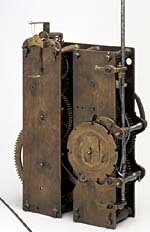
fig. 12.
(click to enlarge)
Early Dutch longcase clock by Anthonius Hoevenaer, view of the movement
from the back, split plates for
This exquisite slim weight-driven black clock,
with a short pendulum, five dials and elaborately ajour-sawn, gilded
foliage-decoration is on display in the museum in Zaandam, but is the
property of the Boerhaave Museum, which also owns a wall clock by
Hoevenaer (more or less similar in construction as the wall clocks by
Oosterwijck in Chicago and Thuret in Leyden). The Zaandam Hoevenaer clock
(definitively one of my favorites) is one of the earliest examples in a
European museum showing hours, minutes, seconds, date and lunar phases.
Like the eighteenth century table or bracket clocks, the early Dutch
longcase clocks show much resemblance to their English counterparts, with
their cherubim-spandrels surrounding the arcaded dial, on which, as a
national feature the Arabic minute-numerals from 20 to 40 are shown
upright in stead of upside down. In the eighteenth century the Dutch
clockmaker could easily order English parts as components for their
stylish timepieces or even have their cases decorated with English
marquetry veneer.
Some late seventeenth or early eighteenth century baroque Amsterdam
longcase clocks, like examples by Fromanteel and Norris, or Pieter Klock
and Steven Huygens, show a carved coif on top of the hood. Later
eighteenth century Dutch longcase clocks excel in voluptuous burr walnut
or mahogany veneered Louis XV or XVI cases and often popular moving
imagery like fishermen and sailing ships automata, musical works or
intricate astronomical features such as lunar and tidal indication, or
even planetarium or planispherium dials. The museum in Zaandam exhibits a
rare longcase clock movement with planetarium-face by Dames Starre of
Hoorn, surrounded by depictions of the four elements (on loan from the
Boerhaave Museum, which houses also the monumental 'Leyden Sphere' by
English clockmaker Stephen Tracy), and a complete Amsterdam longcase clock
by Gerrit Knip (Figs 13 & 14) with planispherium-face and world time
table, an interesting gimmick for the wealthy Amsterdam merchant with
stocks in the East- and West Indies Trading Company.

fig.
13. (click to enlarge)
Amsterdam longcase clock by Gerrit Knip. Collection Rembrandt Society,
on loan to the Museum of the Dutch Clock, Zaandam.
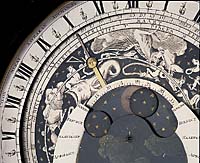
fig.
14. (click to enlarge)
Longcase clock by Gerrit Knip, detail of the dial.
Appropriately this longcase clock is surmounted by an Atlas figure
carrying the celestial globe, copied from the monumental sculpture by
Arthus Quellinus for the Amsterdam Town Hall (currently the Royal Palace
at Dam square). Knip is also known for a handsome large musical bracket
clock in the museum in Utrecht.
 Carillons and regional clocks. Carillons and regional clocks.
The popularity of musical clocks is yet another characteristic of the
country of 'the singing bell towers'. The peak of the construction of
turret carillons occurred between 1630 and 1670 with the clockmakers Jan
Becker van Call, making musical turret clocks for, amongst others, the
Town Hall of Delft and churches in Rotterdam and Darmstadt (Germany), and
especially Jurriaan Spraeckel, making (or revising) clocks for at least
eight major bell towers like the Utrecht Dom, the Bavo in Haarlem, the
Martini-tower in Groningen, the New Church of Kampen, the cupola of the
above mentioned Amsterdam townhall, as well as the Zuider, Wester and Old
Church of Amsterdam, where the most distinguished Dutch composer and
William Byrd contemporary, Jan Pietersz Sweelinck, played the organ. Bells
for these clocks were cast by the Hemony family.

fig. 15.
(click to enlarge)
Stool clock by François de Mey of Amsterdam, with musical work. Collection
Rembrandt Society.
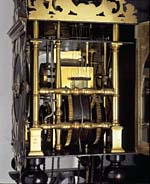
fig.
16. (click to enlarge)
Stool clock by François de Mey, detail of the movement. The maker's
signature is visible on the front piller stand.
The oldest known Dutch domestic clock with musical work, made by François
de Mey of Amsterdam, c.1685, is now in the museum in Zaandam (Figs 15 &
16). This brass wall clock resting on a wooden frame and demonstrating
certain similarities to the lantern clock is also an exceptional example
of the regional wallclock known as the stool clock (stoelklok). The
baroque Zaan stool clock, representative for the villages along the river
Zaan between Amsterdam and Alkmaar, known as the Zaan region, was made
between approximately 1670 and 1740. A unique Zaan clock in the museum in
Zaandam (and a recent acquisition) uses the weight of the movement itself
as power source for the going and striking train with prominent striking
Jack on top of the two bells for both the Dutch striking on the hour and
half hour (Fig. 17). It is dated 1678 and signed by Kornelis Michielsz
Volger, the founder of the Zaan clock industry, in which families like
Koogies and Van Rossen participated. Volger is also known for his turret
clocks, like his younger nephew Dirck Jacobsz, of whom an early stool
clock was described in Antiquarian Horology of spring 1991.

fig.
17.
Rare Zaan clock by Kornelis Michielsz Volger, dated 1678. The Museum
of the Dutch Clock, Zaandam.
The Zaan
region didn't recognize either guilds or other protective regulations for
craftsmen. Zaan clocks often have a motto on the brass bell fret reading
'Nu elck syn sin' (Everymen to his idea) which expresses the dominant
mennonite or humanist view of tolerance and mutual respect, or maybe just
liberal opportunism.
The eighteenth century Frisian stool clock has a painted face, a lead bell
fret and mermaid figures attached to the case. The museum in Zaandam owns
various examples of the Frisian stool clock, like this beautiful example
by Bauke Haanstra of Sneek, dated 1736.
The extremely popular (specifically in Friesland) regional wall clock of
the late eighteenth and early nineteenth century was the so called
staartklok (or tail clock). In common with the Amsterdam longcase clock
the staartklok has a longer pendulum and an anchor escapement, as applied
by the English clockmakers William Clement in the oldest known longcase
clock (1668), also part of the exhibition 'Horological Masterworks', and
by Joseph Gibb in the turret clock for Wadham College, Oxford (1670), now
on display in the Museum of the History of Science, Oxford.
 Precision timekeepers and 'designer clocks'. Precision timekeepers and 'designer clocks'.
The nineteenth century also brought advanced precision timekeepers such as
a mantel clock with compensation pendulum of 1840 by Cornelis van Spanje
in the museum in Schoonhoven, a regulator with compensation pendulum by
Hermann Friedrich Knebel (c. 1840) (Figs 18 & 19) or marine chronometers
by Knebel, Andreas Hohwü, J.P. Dupont & Zoon and Abraham de Casseres (c.
1880-1910). Good examples of chronometers like these are to be found in
the Boerhaave Museum or the University Museum of Utrecht or the museum in
Zaandam.

fig.
18. (click to enlarge)
Regulator by Hermann Friedrich Knebel. Collection Van Braam-Minnesma
on loan to Museum of the Dutch Clock, Zaandam.
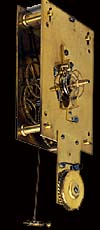
fig.
19. (click to enlarge)
Regulator by Hermann Friedrich Knebel, the movement.
By the time of the early twentieth century, Dutch clockmaking
definitively had lost its dominant position to countries like France,
Germany and Switzerland. Now running on foreign movements it only is the
artistic value of some of the Dutch clock cases by designers like H.P.
Berlage, Jan Eisenloeffel, Hildo Krop and Theo Nieuwenhuys, working in
contemporary styles like the elegant Nieuwe Kunst (the Dutch version of
Modern Style or Jugendstil), the expressionist Amsterdam School or
flamboyant Art Déco, which makes these timepieces highly collectable.
 Conclusion. Conclusion.
I hope this short overview of Dutch masterpieces in clockmaking has given
you an impression of a rather underestimated chapter of our cultural
heritage. It is not only my task as a curator to maintain this heritage,
but also to propagate its cultural role and significance to a much broader
audience. For this, I am much obliged to the Boom-Time Foundation in
initiating a new program for the development of a international website
with a digital catalogue of Dutch signed clocks in public collections.
This website, under the working title of Horologium.nl, combines data
about timekeepers scattered over the various collections in Dutch and
foreign museums and (hopefully) also substantial private collections.
The Dutch of the seventeenth century were an industrious, prosperous but
also a severely religious people. The Hague clock perhaps summarizes best
these characteristics. Trade made them open minded to different
perspectives and possibilities. Great men like Descartes or Comenius found
refuge in this country and brought their ideas. Sometimes Dutch culture
seems a Babylonian hotchpotch and not a real national identity in its own
right, at best a marriage of convenience between a restless movement and a
sheltering case. But in this eclectic spectrum lie the tools for
continuity: Survival through adaptation. Perhaps this we can learn from
the history of the Dutch clock; perhaps this reveals the true identity of
the 'Dutch connection'.
In a proverbial domestic scene by Jan Steen (Fig. 20) a monkey can be
detected interfering the order of things by lifting up the weight of a
wall clock and in this way visualizing a seventeenth century proverb which
found a less-moralizing equivalent in our modern and true saying 'time
flies when you're having fun'.
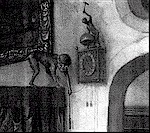
fig.
20. (click to enlarge)
'Monkey business' after Jan Steen (Museum of Arts, Vienna)
In Calvinistic terms it implied a warning
not to neglect our serious duties. As admirers of antique timepieces we
tend to freeze time in order to preserve it like a stylized natura morte.
But contrary to the 'monkey-business' the purpose of a going train, a
movement is without doubt to run. The responsibility for our cultural
heritage is an active one of maintaining and development. That's why I
prefer to end my talk with yet another moralistic image, not of a monkey
but of an old wise man (Fig. 21). In spite of its sexist implication it
illustrates my demanding yet fulfilling work as a curator and maybe of us
all as conscientious horologists.
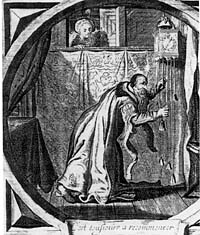
fig.
21.
'C'est toujours a recommencer'
(A. van de Venne, 1658).
There is a title to the image which
reads in the French version:
'Un horologe entretenir, Jeunes dames a gré servir, vieille maison
reparer, est toujours a recommencer'. Or roughly translated: 'To keep a
clock running, to please a lady, to repair an old house, it all sums up in
starting again all the time'.
Now that's Huygens' 'endless rope' for you!
(Oxford, March 29th 2003)
Source: Proceedings of the Fiftieth Anniversary Convention of The
Antiquarian Horological Society, Keble College Oxford, March 2003.
About the author :
Born 1958 in Delft, Pier van Leeuwen studied as a graphic artist at the
Royal Academy of Visual Arts in The Haghe and later as e museologist at
the Reinwardt Academy in Leyden. From 1989 he worked with a number of
Dutch museums in various capacities including those of exhibition
designer, consultant and curator.
In 1997 he became Curator of
The Museum of The
Dutch Clock in Zaandam,
which now exhibits the most complete survey of the history of the Dutch
clock. Pier has several publications to his name including those on such
subjects as Dutch Designer Glass, Modern Sculpture in Zaanstad and the
painter Thijmen Moll of Huizen.
In 2002 Pier started a project for the Boom-Time Foundation in Utrecht,
building a website for a virtual catalogue of Dutch signed clocks which
will be on-line in 2004.
More links:
Dutch Gold, Silver and Clock Museum.
National Museum from Musical
Clock to Street Organ.
Museum of the Dutch
clock.
National Museum of the
History of Science.
 |








